Buzz Haven: Your Daily Dose of News and Information
Stay updated with the latest trends, news, and insights from around the world.
Cosmetics That Confuse: What Even Is Contour?
Unlock the mystery of contouring! Discover what it is and why it’s a game-changer for your makeup routine in this must-read blog!
The Art of Contouring: A Beginner's Guide
The Art of Contouring has become a fundamental practice in the world of beauty, allowing individuals to enhance their facial features and achieve a sculpted appearance. For beginners, understanding the basic techniques and product application is essential. Start by selecting a contour kit that includes both contour and highlight shades. It's advisable to choose a matte contour shade that is a few shades darker than your skin tone, and a highlighter that is a shade or two lighter. To begin, use a contour brush to apply the contour shade to the hollows of your cheeks, the sides of your nose, and along your jawline. Then, apply the highlighter on the tops of your cheekbones, beneath your brow bone, and down the bridge of your nose.
To achieve the perfect blend, it's crucial to utilize a damp makeup sponge or a soft brush for seamless application. Start by blending the contour by using circular motions to avoid harsh lines. Once you're satisfied with the contour, move on to the highlighter, applying it with a gentle tapping motion to maintain the luminosity. Remember, practice makes perfect, so don't hesitate to experiment with different looks to find what suits you best. As you become more comfortable, you'll discover that mastering the art of contouring can dramatically enhance your makeup routine, accentuating your natural beauty in no time!

Contouring Myths Debunked: What You Really Need to Know
Contouring has become a staple in the beauty routines of many, but with its popularity comes a host of myths that can lead to confusion and improper application. One common misconception is that contouring is only for professional makeup artists or those with a certain skill level. In reality, anyone can master the art of contouring with the right products and techniques. By understanding the basics of your face shape and finding the right shades to enhance your natural features, you can achieve a sculpted look that complements your individual beauty.
Another prevalent myth is that contouring requires a heavy hand and excessive product. In fact, less is more when it comes to contouring. Using subtle, buildable formulas will provide a more natural finish, allowing for the art of contouring to blend seamlessly with the skin. Additionally, many believe that contouring products are only limited to powders. However, there are numerous options available, such as cream and liquid formulas, which can offer a dewy, fresh appearance. It's crucial to experiment with different products to find what works best for your skin type and desired look.
Is Contour Right for You? Finding Your Perfect Shade
When it comes to makeup, finding the right contour shade is essential for achieving a natural and sculpted look. Is contour right for you? The answer lies in understanding your skin tone and undertone. First, identify whether your skin has warm, cool, or neutral undertones by examining the veins on your wrist or the colors that complement your complexion. Next, consider your skin tone, which can range from fair to deep. By recognizing these factors, you can make an informed decision on the best contour shades that will enhance your features without appearing dull or overly dramatic.
Once you’ve determined your undertone and skin tone, it’s time to explore the various products available on the market. Contour shades typically come in two forms: cream and powder. Each has its own advantages, and your choice may depend on your personal preference and makeup style. Finding your perfect shade often involves testing different options to see how they blend with your natural skin tone. Remember to apply contour in natural light to ensure the shade complements your complexion seamlessly. Keep these tips in mind, and soon you'll be able to master the art of contouring with confidence!